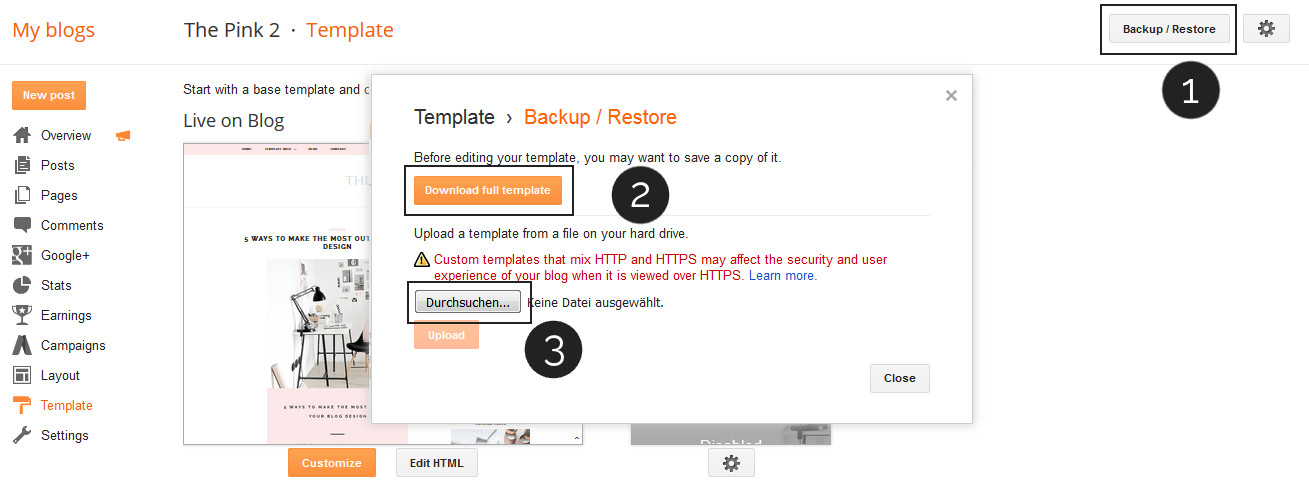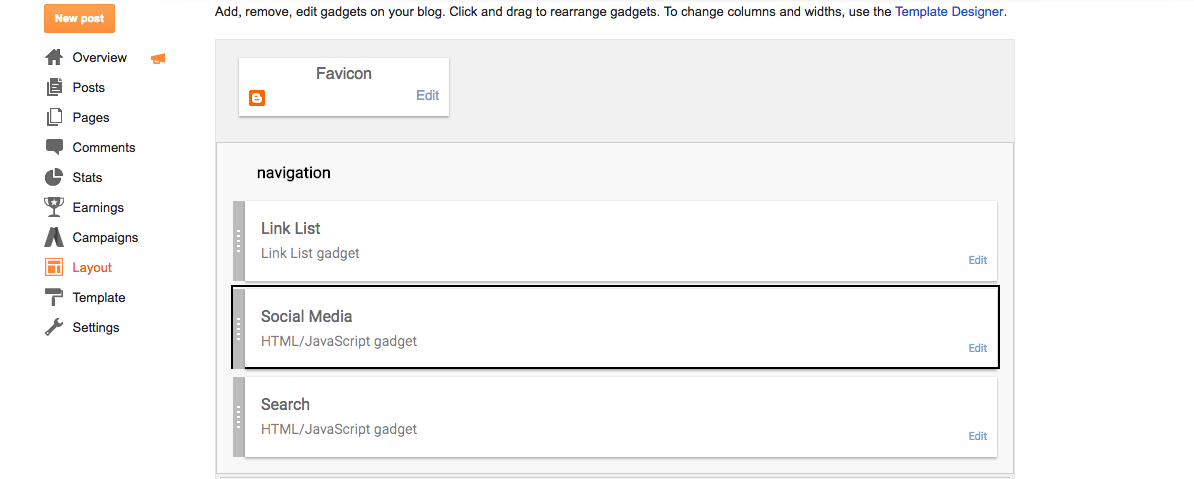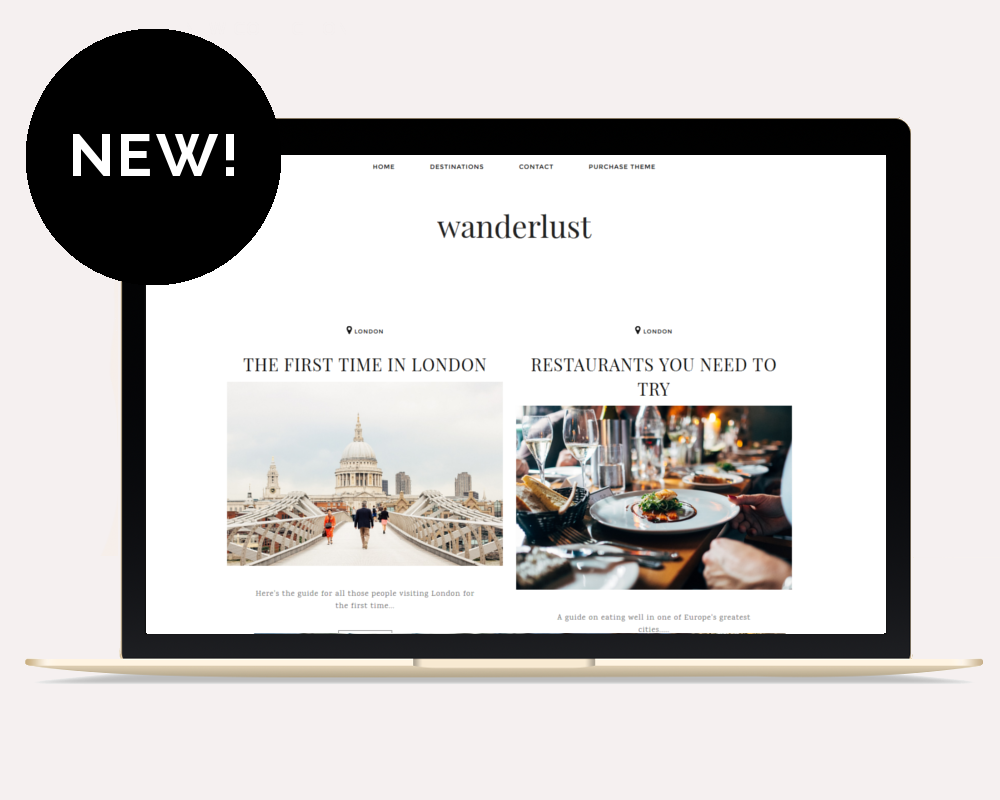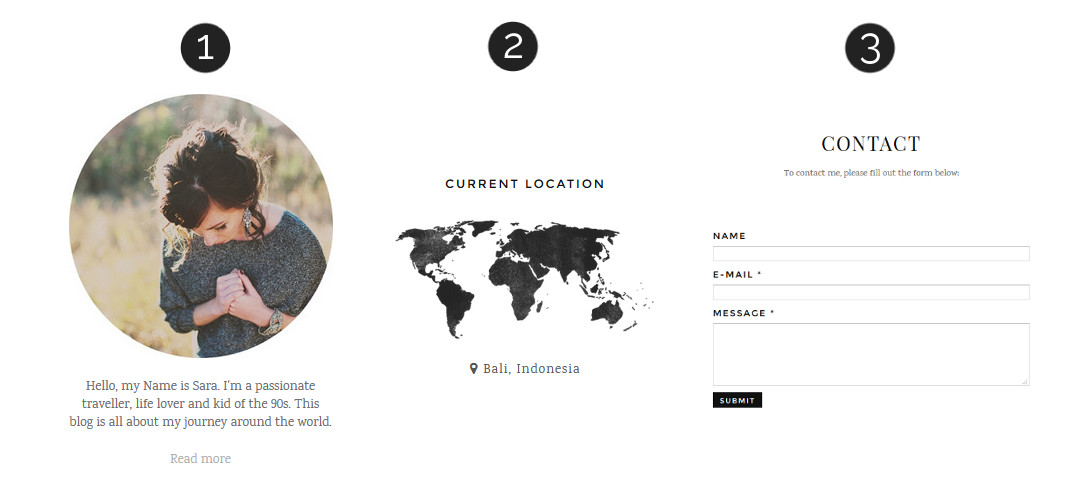- Click on Labels.
- Give your post one or more labels. You can separate them with commas. Please keep in mind that the labels are case sensitive ('Fashion' and 'fashion' is NOT the same label!).
How to add labels to your post
Style Magazine
Step 1: Upload your new Blogger Template

- In your Blogger dashboard go to 'Template'. Click on 'Backup/Restore' in the right corner of the site.
- We recommend to always save your current template if something goes wrong. (Click on the 'Download full template' button to save your template.)
- Now you can go ahead and upload your new template! Upload the '.xml' file that comes in the zip folder you received from us and then simply hit the 'Upload' button.
Step 2: Set up the drop down menu

-
In your Blogger dashboard go to 'Layout'. You will see a LinkList gadget - click edit and follow these steps to set up the menu:
- First-level menu item: The menu item names goes into 'New Site Name' and the URL into 'New Site URL'. Here you can read how to link to label pages.
- Second-level menu item: Works just the same as a first level item, but you have to put an underscore ( _ ) before the item name.
- Please be sure to put all second level items right below the first level item where they should appear. It should look like in the picture above.
Add social media icons

First of all, you need to add the code from socialmedia.txt (it's in the template zip folder you received from us) into a HTML/JavaScript gadget in the Layout section. You need add it to the navigation of the template. This template comes with 25 different social media icons, if you want to add more, you can search them at FontAwesome.
To link the icons to your social media channels follow these steps:
- Insert the adress to your social media profile where it says 'URL_HERE'.
- Now delete all the lines with icons you don't need.
- Example: You want to include Instagram, Pinterest, Facebook and additional a little envelope for your contact details. Your code would look like in the picture above.
Display your Instagram feed in the footer

-
Generate your Instagram Access Token and copy it.
- In your Blogger dashboard, go to 'Template', click 'Edit HTML' and search for 'instafeed' until you find the piece of code in the picture above. (You can search the Blogger Code Editor with Ctrl+F or Cmd+F)
- Paste your Access Token after it reads "AccessToken".
- Your User ID is the first part of your Access Token until the dot. Paste it where it reads "UserID".
- Go back to 'Layout' and paste the code from 'instagram.txt' into a HTML/JavaScript widget in the footer section of your template.
Make your template mobile responsive

Last step! Finally you have to ensure that on smartphones and tablets the mobile responsive version of the template shows and not the ugly Blogger mobile view. To do this, follow these steps:
- In your Blogger dashboard, go to 'Template'. There's a mobile demo view, right below click the settings button.
- In the settings window you have to tick 'No. Show desktop template on mobile devices.'
Important notes to use this template:
- If you want to upload your own header image, you have to select 'Instead of Title and Description'.
- The first picture of every post needs to be uploaded via Blogger to generate the thumbnail image for the homepage and the Popular Posts widget.
- You can easily change the colors of the template in the Blogger Template Designer.
- To make the slider show up, please note that you need to have at least 8 posts on your blog. Each post needs one label (or more). Also, your blog has to be public.
- Want to use different headings in your posts? Read here how to insert heading tags.
En Vogue
Step 1: Upload your new Blogger Template

- In your Blogger dashboard go to 'Template'. Click on 'Backup/Restore' in the right corner of the site.
- We recommend to always save your current template if something goes wrong. (Click on the 'Download full template' button to save your template.)
- Now you can go ahead and upload your new template! Upload the '.xml' file that comes in the zip folder you received from us and then simply hit the 'Upload' button.
Step 2: Set up the drop down menu

- First-level menu item: The menu item names goes into 'New Site Name' and the URL into 'New Site URL'. Here you can read how to link to label pages.
- Second-level menu item: Works just the same as a first level item, but you have to put an underscore ( _ ) before the item name.
- Please be sure to put all second level items right below the first level item where they should appear. It should look like in the picture above.
In your Blogger dashboard go to 'Layout'. You will see a LinkList gadget - click edit and follow these steps to set up the menu:
Add social media icons

First of all, you need to add the code from socialmedia.txt (it's in the template zip folder you received from us) into a HTML/JavaScript gadget in the Layout section. You can add it to the navigation (recommended) and to the sidebar of the template. This template comes with 25 different social media icons, if you want to add more, you can search them at FontAwesome.
To link the icons to your social media channels follow these steps:
- Insert the adress to your social media profile where it says 'URL_HERE'.
- Now delete all the lines with icons you don't need.
- Example: You want to include Instagram, Pinterest, Facebook and additional a little envelope for your contact details. Your code would look like in the picture above.
Add custom widgets (About, Weekly favorites)
Your template comes with different custom widgets - some of them will appear automatically, some have to be added and customized manually.
- About widget: Paste the code from about.txt into a HTML/JavaScript widget in the sidebar. All instructions on how to add your own profile photo and text come within the text file.
- "Weekly favorites" widget: To display a collection of your favorite products you have to sign up for an affiliate network. I'd recommend to use Shopstyle Collective - it's free, easy to use and offers dozens of possibilities to create widgets, shops and more. After your registration you can copy the widget code from there and paste it into the Blogger gadget in the Layout section.
Display your Instagram feed in the footer

-
Generate your Instagram Access Token and copy it.
- In your Blogger dashboard, go to 'Template', click 'Edit HTML' and search for 'instafeed' until you find the piece of code in the picture above. (You can search the Blogger Code Editor with Ctrl+F or Cmd+F)
- Paste your Access Token after it reads "AccessToken".
- Your User ID is the first part of your Access Token until the dot. Paste it where it reads "UserID".
- Go back to 'Layout' and paste the code from 'instagram.txt' into a HTML/JavaScript widget in the footer section of your template.
Make your template mobile responsive

Last step! Finally you have to ensure that on smartphones and tablets the mobile responsive version of the template shows and not the ugly Blogger mobile view. To do this, follow these steps:
- In your Blogger dashboard, go to 'Template'. There's a mobile demo view, right below click the settings button.
- In the settings window you have to tick 'No. Show desktop template on mobile devices.'
You can now check your new responsive template on your smartphone or head over to isResponsive to test if it works.
Important notes to use this template:
- If you want to upload your own header image, you have to select 'Instead of Title and Description'.
- The first picture of every post needs to be uploaded via Blogger to generate the thumbnail image for the homepage and the Popular Posts widget.
- You can easily change the colors of the template in the Blogger Template Designer.
- Want to use different headings in your posts? Read here how to insert heading tags.
The Pink

Step 1: Upload your new Blogger Template

- In your Blogger dashboard go to 'Template'. Click on 'Backup/Restore' in the right corner of the site.
- We recommend to always save your current template if something goes wrong. (Click on the 'Download full template' button to save your template.)
- Now you can go ahead and upload your new template! Upload the '.xml' file that comes in the zip folder you received from us and then simply hit the 'Upload' button.
Step 2: Set up the drop down menu

- First-level menu item: The menu item names goes into 'New Site Name' and the URL into 'New Site URL'. Here you can read how to link to label pages.
- Second-level menu item: Works just the same as a first level item, but you have to put an underscore ( _ ) before the item name.
- Please be sure to put all second level items right below the first level item where they should appear. It should look like in the picture above.
In your Blogger dashboard go to 'Layout'. You will see a LinkList gadget - click edit and follow these steps to set up the menu:
Add social media icons
First of all, you need to add the code from socialmedia.txt (it's in the template zip folder you received from us) into the 'Social Media' gadget in the Layout section. This template comes with 25 different social media icons, if you want to add more, you can search for them at FontAwesome.
To link the icons to your social media channels follow these steps:
- Insert the adress to your social media profile where it says 'URL_HERE'.
- Now delete all the lines with icons you don't need.
- Example: You want to include Instagram, Pinterest, Facebook and additional a little envelope for your contact details. Your code would look like in the picture above.
Add custom widgets (About, Weekly favorites, Contact form)
Your template comes with different custom widgets - some of them will appear automatically, some have to be added and customized manually.
- About widget: Paste the code from about.txt into a HTML/JavaScript widget in the sidebar. All instructions on how to add your own profile photo and text come within the text file.
- "Weekly favorites" widget: To display a collection of your favorite products you have to sign up for an affiliate network. I'd recommend to use Shopstyle Collective - it's free, easy to use and offers dozens of possibilities to create widgets, shops and more. After your registration you can copy the widget code from there and paste it into the Blogger gadget in the Layout section.
- Contact Form: First, add a Contact Form widget anywhere in the Layout section (e.g. sidebar, footer). Then go to Pages (on the left menu of your Blogger dashboard) and add a new page. Paste the code from contactform.txt into the HTML of this page and save.
Display your Instagram feed in the footer

-
Generate your Instagram Access Token and copy it.
- In your Blogger dashboard, go to 'Template', click 'Edit HTML' and search for 'instafeed' until you find the piece of code in the picture above. (You can search the Blogger Code Editor with Ctrl+F or Cmd+F)
- Paste your Access Token after it reads "AccessToken".
- Your User ID is the first part of your Access Token until the dot. Paste it where it reads "UserID".
- Go back to 'Layout' and paste the code from 'instagram.txt' into a HTML/JavaScript widget in the footer section of your template.
Make your template mobile responsive

Last step! Finally you have to ensure that on smartphones and tablets the mobile responsive version of the template shows and not the ugly Blogger mobile view. To do this, follow these steps:
- In your Blogger dashboard, go to 'Template'. There's a mobile demo view, right below click the settings button.
- In the settings window you have to tick 'No. Show desktop template on mobile devices.'
You can now check your new responsive template on your smartphone or head over to isResponsive to test if it works.
Important notes to use this template:
- If you want to upload your own header image, you have to select 'Instead of Title and Description'.
- The first picture of every post needs to be uploaded via Blogger to generate the thumbnail image for the homepage and the Popular Posts widget.
- To make the Popular Posts widget look like in the demo version, select title and thumbnail.
- You can easily change the colors of the template in the Blogger Template Designer.
- Want to use different headings in your posts? Read here how to insert heading tags.
- To find tips to improve your blog with The Pink template, you can read this post on how to make the most out of your blog.
Wanderlust

Step 1: Upload your new Blogger Template

- In your Blogger dashboard go to 'Template'. Click on 'Backup/Restore' in the right corner of the site.
- We recommend to always save your current template if something goes wrong. (Click on the 'Download full template' button to save your template.)
- Now you can go ahead and upload your new template! Upload the '.xml' file that comes in the zip folder you received from us and then simply hit the 'Upload' button.
Step 2: Set up the drop down menu

- First-level menu item: The menu item names goes into 'New Site Name' and the URL into 'New Site URL'. Here you can read how to link to label pages.
- Second-level menu item: Works just the same as a first level item, but you have to put an underscore ( _ ) before the item name.
- Please be sure to put all second level items right below the first level item where they should appear. It should look like in the picture above.
In your Blogger dashboard go to 'Layout'. You will see a LinkList gadget - click edit and follow these steps to set up the menu:
Add social media icons
First of all, you need to add the code from socialmedia.txt (it's in the template zip folder you received from us) into a HTML/JavaScript gadget in the Layout section. You can add it to the sidebar (recommended) and to the footer of the template. This template comes with 25 different social media icons, if you want to add more, you can search them at FontAwesome.
To link the icons to your social media channels follow these steps:
- Insert the adress to your social media profile where it says 'URL_HERE'.
- Now delete all the lines with icons you don't need.
- Example: You want to include Instagram, Pinterest, Facebook and additional a little envelope for your contact details. Your code would look like in the picture above.
Add custom widgets (About, Current Location, Contact form)

Your template comes with different custom widgets - some of them will appear automatically, some have to be added and customized manually.
- About widget: Paste the code from about.txt into a HTML/JavaScript widget in the sidebar. All instructions on how to add your own profile photo and text come within the text file.
- Current Location (worldmap): Same as about widget - there's a currentlocation.txt in the zip folder you received from us. Paste the code into a HTML/JavaScript widget and follow the instructions in the text file to customize it.
- Contact Form: First, add a Contact Form widget anywhere in the Layout section (e.g. sidebar, footer). Then go to Pages (on the left menu of your Blogger dashboard) and add a new page. Paste the code from contactform.txt into the HTML of this page and save.
Display your Instagram feed in the footer

-
Generate your Instagram Access Token and copy it.
- In your Blogger dashboard, go to 'Template', click 'Edit HTML' and search for 'instafeed' until you find the piece of code in the picture above. (You can search the Blogger Code Editor with Ctrl+F or Cmd+F)
- Paste your Access Token after it reads "AccessToken".
- Your User ID is the first part of your Access Token until the dot. Paste it where it reads "UserID".
- Go back to 'Layout' and paste the code from 'instagram.txt' into a HTML/JavaScript widget in the footer section of your template.
Make your template mobile responsive

Last step! Finally you have to ensure that on smartphones and tablets the mobile responsive version of the template shows and not the ugly Blogger mobile view. To do this, follow these steps:
- In your Blogger dashboard, go to 'Template'. There's a mobile demo view, right below click the settings button.
- In the settings window you have to tick 'No. Show desktop template on mobile devices.'
You can now check your new responsive template on your smartphone or head over to isResponsive to test if it works.
Important notes to use this template:
- If you want to upload your own header image, you have to select 'Instead of Title and Description'.
- The first picture of every post needs to be uploaded via Blogger to generate the thumbnail image for the homepage.
- To make the archive gadget look like in the demo version, select 'Flat List'.
- This template doesn't work with the Blogger Template Designer.
How to use Heading tags in Blogger posts
SEO tip: A logical hierachy of heading tags both in your template and your blog posts is very important for the SEO friendliness of your blog. Using headings and subheadings makes search engines understand the structure of your site (or post) and which parts are more important than others.
You should always use subheadings (h2, h3, h4) in your blog posts - the most important heading h1 is your post title, it's shouldn't be used in blog posts!
2 ways how to add headings to your posts in Blogger
- Through Blogger's Post Editor
- Through code

There is a simply function in Blogger's post editor that makes it more than easy to add heading and subheading tags your posts. Highlight the words you want to put in the heading and in the settings (see picture) select 'Heading' for a h2 heading, 'Subheading' for h3, and 'Minor Heading' for h4. That's all.

Another way of adding heading tags is to insert them directly in the code. Therefore, you have to switch to the HTML text in the post editor (in the left corner, there is a button called 'HTML'). Then search for the text of your heading and wrap it in the tags you want to have. Example in the picture above, there's a h2 tag:
<h2> YOUR HEADLINE TEXT</h2>
FAQ
I have problems with the installation. Can you help me?
Of course! We are always here to help you when problem with your template appear. Please write an email to contact@munichparis.com describing your problem.If you don't want to do the installation on your own, you can also purchase our Installation Add-on and we will take care of the whole setup in no time!
Can I use my template with Blogger's Template Designer to change fonts, colors and backgrounds?
Yes, some of my templates do support the Template Designer - some don't. Please check in your template's documentation or ask beforehand.How do I add the product widgets (Weekly Favorites, Shop the post)?
You have to sign up for an affiliate network to create these widgets - read this article to find out how it works and how you can make money through affiliate links with your blog.The slider in my template doesn't work. What can I do?
In order to find the problem, please follow these steps and check if your blog lacks any of these things:1.You have at least 5 posts on your blog.
2.Each post has at least one label assigned (Tutorial: How to add labels to Blogger posts)
3.Your blog is public.
4.You didn't add third-party scripts that call jquery (Tutorial: What is jquery and why can it cause problems?)
If your answer is yes to all these questions, please contact me and I will help you fix the problem!





